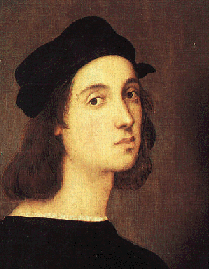Renaissance Painter, 1483-1520
Have you noticed that the streets of Myville are all named after
famous scientists and artists from the Renaissance? In case these folks
aren't so famous to you, you might want to follow along this series of
articles, and get to know the person on whose street you're living.
This week's article is about a famous Italian painter who doubled as an architect and archeologist on the side.

by Lois Lee
Times
Staff
|
Raffaello Santi, shortened to Raphael early in life, was born in Urbino, Italy, on April 6th, 1483. When Raphael was eight years old, his mother died. Raphael's father, Giovanni di Sanati, was also an artist and was Raphael's first art teacher. Unfortunately, Raphael's father died when Raphael was only eleven years old and left Raphael with his stepmother.
The death of his father did not stop Raphael from painting. He went on to study with two almost unknown painters, Evangelista di Melato and Temoteo Viti, until his uncle, Simon Ciarla took him to Perugia, Italy where he became apprenticed to a well known artist, Pietro Perugino. Under Perugino Raphael thrived and was already making a name for himself by the time he was sixteen years old.
Raphael's fame grew as he grew. When Raphael was twenty-one, he moved to Florence, the artistic center of Europe where he met and studied with Michelangelo and Leonardo da Vinci. He stayed in Florence for only three years before moving to Rome in 1508, at the request of Pope Julius II who had seen several of Raphael's sketches and paid him to paint murals on the walls of four room's in the Pope's apartment at the Vatican. One of Raphael's most famous paintings is on one of these walls; it is called 'School of Athens'.
 When Pope Julius II died in 1513, his successor, Leo X (that's X as in 10th, not X as in Malcolm X), appointed Raphael to work alongside Donato Bramante in the rebuilding of St. Peter's Basilica. Unfortunately for Bramante, but fortunately for Raphael, Bramante died and Leo made Raphael head of the project. Leo also paid Raphael to plan what would go on ten wall hangings for the Sistine Chapel. As if this wasn't enough to keep Raphael busy, during this time he was also made head of antiques for the city, and drew an archaeological map of Rome.
When Pope Julius II died in 1513, his successor, Leo X (that's X as in 10th, not X as in Malcolm X), appointed Raphael to work alongside Donato Bramante in the rebuilding of St. Peter's Basilica. Unfortunately for Bramante, but fortunately for Raphael, Bramante died and Leo made Raphael head of the project. Leo also paid Raphael to plan what would go on ten wall hangings for the Sistine Chapel. As if this wasn't enough to keep Raphael busy, during this time he was also made head of antiques for the city, and drew an archaeological map of Rome.
Raphael spent the last twelve years of his life in Rome and became known not only for his artistic creations but also for his talents as an archeologist and as an architect. Not bad for an orphan from Urbino! Many other artists' work in this time period were not appreciated until many years after their deaths.
So, why were Raphael's paintings so well liked? At the time when Raphael was painting, there were many changes occurring in Europe; artists and scientists "blossomed" from the more straightlaced attitudes of the Middle Ages, revitalizing Western art, philosophy, and science. Raphael liked to paint portraits and scenes from nature. He used rich colors and brought emotion to his paintings. This was a big change from the art of the Middle Ages and apparently one that people liked. Raphael was also a really hard worker; to give you an idea of how many paintings Raphael painted: we know that Raphael painted more than 300 pictures of the Madonna (the mother of Jesus, not the rock star) alone, and his life was not a long one.
Raphael died in Rome on his 37th birthday, April 6, 1520. He is still regarded as one of the three greatest artists of that time (with the esteemed company of Michelangelo and Leonardo da Vinci).